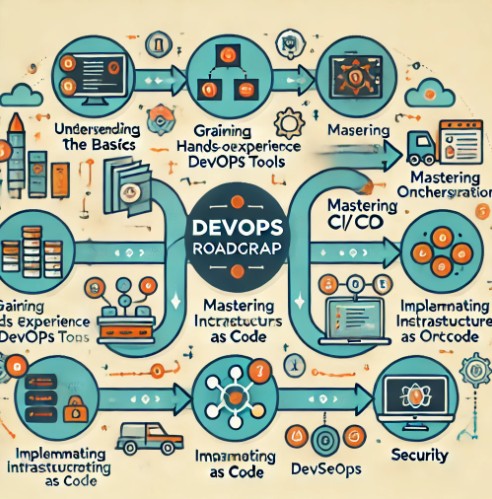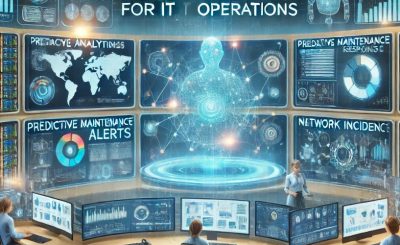Table of Contents
- 1 Introduction: Understanding the DevOps Roadmap
- 2 What Is DevOps and Why Does It Matter?
- 3 Stages of the DevOps Roadmap
- 3.1 1. Understanding the Basics of DevOps
- 3.2 2. Gaining Hands-on Experience with DevOps Tools
- 3.3 3. Mastering Continuous Integration and Continuous Delivery (CI/CD)
- 3.4 4. Managing Containers and Orchestration
- 3.5 5. Implementing Infrastructure as Code (IaC)
- 3.6 6. Monitoring and Logging
- 3.7 7. Security in DevOps (DevSecOps)
- 4 Advanced DevOps Concepts
- 5 FAQ: Common Questions About the DevOps Roadmap
- 6 Conclusion: Mastering the DevOps Roadmap
Introduction: Understanding the DevOps Roadmap
In today’s rapidly evolving tech landscape, organizations are increasingly adopting DevOps practices to streamline their software development and operational workflows. A DevOps roadmap serves as a step-by-step guide for professionals seeking to integrate development and operations seamlessly. It outlines the necessary skills, tools, and methodologies required to successfully implement DevOps across the lifecycle of an application.
Whether you’re an aspiring DevOps engineer, software developer, or system administrator, understanding and following the DevOps roadmap can significantly boost your career. This guide will break down the key stages, tools, and best practices that will enable you to master DevOps, from the basics to more advanced strategies.
What Is DevOps and Why Does It Matter?
DevOps is a cultural and technical movement that combines development (Dev) and operations (Ops) to improve collaboration and productivity. It emphasizes automation, continuous integration (CI), continuous deployment (CD), and the use of feedback loops to iterate faster and improve software quality.
By aligning development and operations teams, DevOps enables:
- Faster delivery of high-quality software
- Enhanced collaboration between teams
- Reduced costs through automation
- Higher customer satisfaction due to improved uptime and quicker feature releases
The DevOps roadmap is a structured guide that outlines how individuals and teams can move from novice to expert by acquiring the necessary skills and tools.
Stages of the DevOps Roadmap
1. Understanding the Basics of DevOps
To start your DevOps journey, you must first understand the fundamental principles and concepts. Here’s what you should focus on:
Core Concepts:
- Version Control: Tools like Git and SVN are crucial for tracking changes in code and collaborating effectively with your team.
- Automation: Automation tools such as Jenkins and Ansible help streamline repetitive tasks, improving efficiency.
- Continuous Integration and Continuous Delivery (CI/CD): Learn how to automate testing, building, and deployment processes to release code more frequently and reliably.
Essential Skills:
- Collaboration: A DevOps culture thrives on open communication and shared responsibilities across the development and operations teams.
- Basic Scripting Knowledge: Start by learning basic scripting languages like Bash or Python for automation tasks.
2. Gaining Hands-on Experience with DevOps Tools
Once you’re comfortable with the basics, it’s time to get hands-on experience with the tools that power DevOps practices. Here are some of the most commonly used tools in the DevOps pipeline:
Key Tools for Developers and Operations Teams:
- Git: A version control system that allows teams to collaborate on code changes.
- Jenkins: A popular CI/CD tool for automating the process of building, testing, and deploying software.
- Docker: A platform for creating, deploying, and managing containers, ensuring consistent environments across all stages of development.
- Kubernetes: A container orchestration tool that helps manage the deployment and scaling of containerized applications.
- Terraform: A tool for automating infrastructure provisioning, enabling the infrastructure-as-code (IaC) approach.
Setting Up a Basic CI/CD Pipeline:
- Install Jenkins or another CI tool.
- Create a simple pipeline that pulls code from Git.
- Set up automated unit tests and code quality checks.
- Configure the pipeline to deploy the application to a development server.
3. Mastering Continuous Integration and Continuous Delivery (CI/CD)
CI/CD is at the heart of DevOps. By automating code integration and delivery, you ensure that code changes are continuously tested and deployed. Here’s what you need to know to master CI/CD:
Key Concepts:
- Continuous Integration (CI): The practice of merging all developers’ working copies to a shared mainline multiple times a day.
- Continuous Delivery (CD): Extending CI by automating the deployment of code to production, making it possible to release software at any time.
Tools to Learn:
- GitLab CI/CD: An integrated DevOps platform for version control and CI/CD.
- CircleCI: A cloud-native CI/CD tool that integrates well with many different version control systems.
- Travis CI: A hosted CI/CD service that automatically builds and tests code changes in GitHub repositories.
4. Managing Containers and Orchestration
As DevOps moves forward, managing applications through containers is essential. Here’s what you need to do:
Learn About Containers:
- Docker: The foundational technology for creating, deploying, and running applications in containers.
- Kubernetes: An orchestration tool that automates the deployment, scaling, and management of containerized applications.
Best Practices:
- Containerize your applications for easier deployment across different environments.
- Use Docker Compose to manage multi-container applications.
- Learn to use Helm for managing Kubernetes deployments.
5. Implementing Infrastructure as Code (IaC)
Infrastructure as Code is a key principle of DevOps. It allows teams to provision and manage infrastructure using code rather than manual configuration. Here are the key tools and practices:
Popular IaC Tools:
- Terraform: For provisioning infrastructure and services on multiple cloud providers.
- Ansible: A configuration management tool that automates server setup and management.
- Puppet and Chef: Other popular tools for automating infrastructure management.
Best Practices:
- Write declarative code to define the desired state of your infrastructure.
- Use version control for your IaC configurations to track changes over time.
- Implement automated testing for your infrastructure code to ensure it is error-free.
6. Monitoring and Logging
Monitoring and logging are critical for ensuring that applications perform well and remain reliable. By monitoring application performance and collecting logs, DevOps teams can proactively resolve issues before they affect users.
Key Tools:
- Prometheus and Grafana: Open-source tools for monitoring and visualizing system metrics.
- ELK Stack (Elasticsearch, Logstash, Kibana): A set of tools for searching, analyzing, and visualizing log data in real time.
7. Security in DevOps (DevSecOps)
DevSecOps integrates security into the DevOps pipeline, ensuring that security is not an afterthought. Here are the steps to implement a secure DevOps process:
- Automate security testing within your CI/CD pipelines.
- Use static code analysis tools like SonarQube to detect vulnerabilities in the code early.
- Implement security policies and guidelines for your DevOps teams.
Advanced DevOps Concepts
Once you’ve mastered the basics and gained some hands-on experience, consider diving into advanced concepts such as:
1. Microservices Architecture
- The microservices approach breaks down large applications into smaller, independent services. This enables faster development, testing, and scaling.
2. Serverless Computing
- With serverless, developers can focus on writing code without worrying about managing infrastructure. AWS Lambda, Google Cloud Functions, and Azure Functions are key platforms in this space.
3. Cloud-Native Technologies
- Learn how to design, build, and manage applications specifically for the cloud, leveraging cloud services like AWS, Azure, and GCP.
FAQ: Common Questions About the DevOps Roadmap
What is the first step in the DevOps roadmap?
The first step is understanding the core principles of DevOps, such as continuous integration, continuous delivery, version control, and automation.
How long does it take to master DevOps?
Becoming proficient in DevOps can take anywhere from 6 months to a few years, depending on your experience level, the tools you learn, and the depth of your practice.
Do I need to learn coding for DevOps?
Yes, basic scripting knowledge (e.g., Python, Bash) is essential for automating tasks, creating pipelines, and managing infrastructure.
What tools should I start learning first in DevOps?
Start with tools like Git (for version control), Jenkins (for CI/CD), Docker (for containerization), and Kubernetes (for orchestration).

Conclusion: Mastering the DevOps Roadmap
The DevOps roadmap is a comprehensive guide to mastering the principles, tools, and techniques that drive modern software development and operations. By following this roadmap, you can acquire the necessary skills to help organizations build faster, more reliable applications, and improve collaboration between development and operations teams.
By mastering the tools and concepts from version control to infrastructure automation, you’ll be well on your way to becoming a successful DevOps engineer. Stay committed to learning, experimenting, and evolving with the latest technologies, and you’ll be equipped to succeed in this rapidly growing field.
For further reading, check out these resources:
With the right roadmap, your journey into DevOps will be smooth and rewarding. Thank you for reading the DevopsRoles page!
